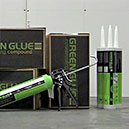How Does Green Glue Noiseproofing Compound Work?
- 27 July 2015
- Posted by: Madhuraka
- Category: Article
 When your attention is reserved for standard pollution issuess, you’re well on your way to a clean home and street. The air is sweet and fresh. Smog is blown away and everyone wins. Noise pollution is tougher to kill. Sound vibrations can’t be neutralized by blowing a puff of cleanser on a sound wave. Instead, you need to place a soundproofing barrier between you and the noise. There are countless solutions to this acoustic attenuation issue, of which green glue noiseproofing jumps to the fore by delivering multiple benefits. It’s the affordable solution, the easy to apply answer, and it’s the solution that delivers when it comes to quoting the important hard numbers that sell a product. This is a sealant that dampens ninety percent of all noise, leaving only a thin subliminal rumble instead of an impossible to ignore roar. How does green glue noiseproofing perform this sound reduction magic? The answer comes from vibration absorption, the science of acoustics and noise reduction as applied to the transmission of sound across a mechanical form.
When your attention is reserved for standard pollution issuess, you’re well on your way to a clean home and street. The air is sweet and fresh. Smog is blown away and everyone wins. Noise pollution is tougher to kill. Sound vibrations can’t be neutralized by blowing a puff of cleanser on a sound wave. Instead, you need to place a soundproofing barrier between you and the noise. There are countless solutions to this acoustic attenuation issue, of which green glue noiseproofing jumps to the fore by delivering multiple benefits. It’s the affordable solution, the easy to apply answer, and it’s the solution that delivers when it comes to quoting the important hard numbers that sell a product. This is a sealant that dampens ninety percent of all noise, leaving only a thin subliminal rumble instead of an impossible to ignore roar. How does green glue noiseproofing perform this sound reduction magic? The answer comes from vibration absorption, the science of acoustics and noise reduction as applied to the transmission of sound across a mechanical form.
It’s true that sound is defined as the smallest of airborne vibrations, the knocking of one air molecule onto the next, and so on. The obvious answer to this vibrational domino effect would be to eliminate the air and leave the space as a vacuum, a zone where vibrations couldn’t exist. Unfortunately, this less than practical solution would be harmful to you and your loved ones. The next best answer is to produce a sealant that incorporates polymeric functions, features that are targeted at absorbing certain sound frequencies. A green glue noiseproofing solution dampens sound in this exact manner, but it has to be applied in a manufacturer-approved method to receive the full benefits of the system. A common installation practice involves sandwiching the compound between two drywall panels and letting the new wall absorb the sound. There are, of course, a multitude of ways to incorporate building materials with your soundproofing solution, but let’s not stray from the science of the issue.
As you’ve just gained a quick and practical breakdown on how sound moves and how green glue compound dampens the noise before it reaches your delicate ears, this might be a good time to adopt a more science-savvy view. Sound travels in waves. Those waves are attenuated and blunted when they penetrate a physical object, but the amount of attenuation depends on the mechanical properties of that object. Additionally, the object can impart additional acoustic components. A wall, for example, will add echo to music and voices. Green glue is formulated with a precise molecular profile, a pliable structure that targets low frequency sound. Raw bass noise pumped out of a big speaker is dampened by this special formula, as is the echo and hollow boom of loud voices. Amplified electronics-generated audio or mechanical sound and natural noise, a green glue coating neutralizes sound quickly and easily.

